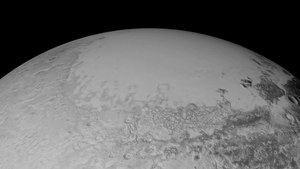Hillary Montes
 The Hillary Montes as viewed by New Horizons on 14 July 2015 | |
| Location | Tombaugh Regio, Pluto |
|---|---|
| Coordinates | 5°N 170°E / 5°N 170°ECoordinates: 5°N 170°E / 5°N 170°E |
| Peak | 3.5±0.4 km (2.2±0.2 mi)[1] |
| Eponym | Edmund Hillary |
The Hillary Montes /ˈhɪləri
Contents
Naming[edit]
The mountains are named after Sir Edmund Hillary,[5][6] New Zealand mountaineer, who, along with Nepalese Sherpa mountaineer, Tenzing Norgay, were the first climbers to reach the summit of the highest peak on Earth, Mount Everest, on 29 May 1953.[7] On 7 September 2017, the name Hillary Montes was officially approved together with the names of Tombaugh Regio and twelve other nearby surface features.[8]
Relative size[edit]
The Hillary Montes rise to 3.5 km (2.2 mi; 11,000 ft) high from base to peak,[1] about half as high as the Norgay Montes. The Hillary Montes are similar in height to that of the peak of Mount Fuji, the highest mountain in Japan, above sea level.[it would be more informative to have a mountain comparable in btp height]
Gallery[edit]
Pluto - map features
(context; 29 July 2015).
Pluto – Hillary Montes and Norgay Montes
(context; 14 July 2015).Hillary Montes and Norgay Montes
(context; 14 July 2015).Hillary Montes and Norgay Montes on Pluto
(context; 14 July 2015).[2]
Near-sunset view includes several layers of atmospheric haze.
Videos[edit]
See also[edit]
- Geography of Pluto
- Geology of Pluto
- List of geological features on Pluto
- List of tallest mountains in the Solar System
Notes[edit]
- ^ Or /ˈmɒnteɪz/
References[edit]
- ^ a b c Schenk, P. M.; Beyer, R. A.; McKinnon, W. B.; Moore, J. M.; Spencer, J. R.; White, O. L.; Singer, K.; Nimmo, F.; Thomason, C.; Lauer, T. R.; Robbins, S.; Umurhan, O. M.; Grundy, W. M.; Stern, S. A.; Weaver, H. A.; Young, L. A.; Smith, K. E.; Olkin, C. (2018). "Basins, fractures and volcanoes: Global cartography and topography of Pluto from New Horizons". Icarus. 314: 400–433. Bibcode:2018Icar..314..400S. doi:10.1016/j.icarus.2018.06.008.
- ^ a b Gipson, Lillian (24 July 2015). "New Horizons Discovers Flowing Ices on Pluto". NASA. Retrieved 25 July 2015.
- ^ Messier, Doug (24 July 2015). "Fly Over Pluto's Icy Plains & Hillary Mountains". Parabolicarc.com. Retrieved 24 July 2015.
- ^ Staff (17 July 2015). "NASA - Video (01:20) - Animated Flyover of Pluto's Icy Mountain and Plains". NASA & YouTube. Retrieved 18 July 2015.
- ^ Staff (25 July 2015). "Pluto mountain range named after Sir Edmund Hillary". Stuff.co.nz. Retrieved 17 August 2015.
- ^ Staff (24 July 2015). "NASA names Pluto's mountains after Sir Edmund Hillary". Television New Zealand. Retrieved 17 August 2015.
- ^ Pokhrel, Rajan (19 July 2015). "Nepal's mountaineering fraternity happy over Pluto mountains named after Tenzing Norgay Sherpa - Nepal's First Landmark In The Solar System". The Himalayan Times. Retrieved 19 July 2015.
- ^ "Pluto Features Given First Official Names". NASA. 7 September 2017.










.jpg/90px-Charon_in_Color_(HQ).jpg)